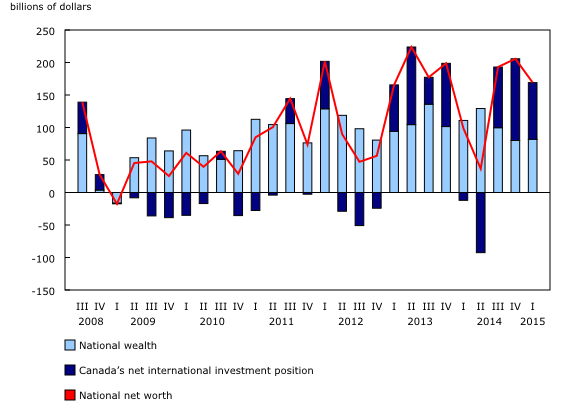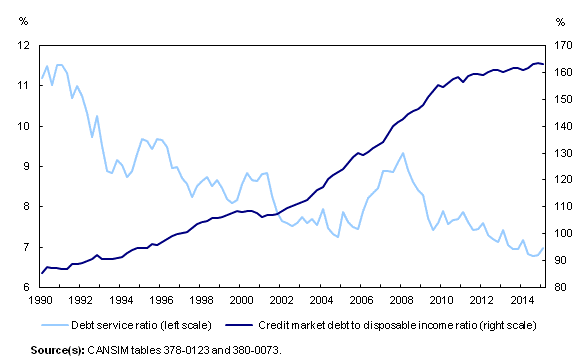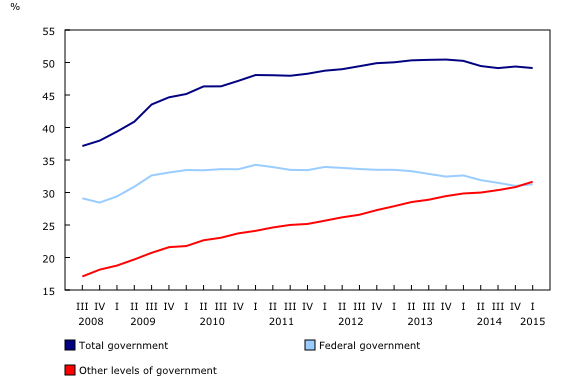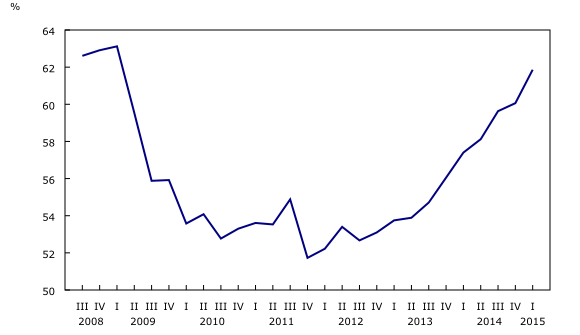National balance sheet and financial flow accounts, first quarter 2015
Archived Content
Information identified as archived is provided for reference, research or recordkeeping purposes. It is not subject to the Government of Canada Web Standards and has not been altered or updated since it was archived. Please "contact us" to request a format other than those available.
Released: 2015-06-12
National net worth
National net worth rose 2.0% or by $169.0 billion from the fourth quarter to $8,434 billion at the end of the first quarter. Among the sectors of the economy, the increasing net worth of households was the primary contributor to growth of national net worth. On a per capita basis, national net worth grew 1.8% to $235,700.
Just over half of the increase in national net worth was attributable to an $87.2 billion advance in Canada's net international investment position, as Canada's net asset position reached a record $224.3 billion at the end of the first quarter. This growth was mainly explained by the larger revaluation effect of a weaker Canadian dollar on Canada's international assets than liabilities. This marks the third straight quarter in which Canada has been a net creditor nation.
National wealth, or the total value of non-financial assets in the Canadian economy, increased by $81.9 billion to $8,209 billion at the end of the first quarter.
Households
Household sector net worth at market value rose 3.4% in the first quarter. On a per capita basis, household net worth advanced 3.2% to $241,800. Non-financial assets, primarily real estate, rose 1.2% while net financial assets were up 6.2%. The gain in net financial assets was largely due to growth in the value of mutual funds and pension assets. The larger increase in the value of financial assets pushed the ratio of financial assets to non-financial assets up to 125.7%, the highest level since the second quarter of 2002. Financial assets represented 55.7% of total household assets at the end of the quarter.
The ratio of total household debt to total assets declined to 17.8% in the first quarter, continuing a general downward trend that began in 2009. Since then, asset prices have rebounded significantly, but the ratio of household debt to total assets has not yet returned to pre-recession levels.
On a seasonally adjusted basis, households borrowed $23.0 billion in the first quarter, up slightly (+0.4%) from the fourth quarter. Mortgages made up the largest portion of total borrowing in the quarter ($15.9 billion), down 0.8% from the previous quarter, while consumer credit represented $4.8 billion of borrowing in the first quarter.
Total household credit market debt (consumer credit, and mortgage and non-mortgage loans) reached $1,841 billion at the end of the first quarter, up 0.7% from the previous quarter. Consumer credit debt was $519.5 billion, while mortgage debt stood at $1,197 billion.
After increasing for three consecutive quarters, leverage, as measured by household credit market debt to disposable income, edged down to 163.3% in the first quarter from 163.6% in the fourth quarter. Disposable income (+0.9%) increased at a faster pace than household credit market debt (+0.7%).
The household debt service ratio, defined as household mortgage and non-mortgage interest paid as a proportion of disposable income, continued to hover at a historic low.
Government sector
The federal government was a net borrower of $7.4 billion in the first quarter, compared with net borrowing of $10.7 billion in the first quarter of 2014. Other levels of government continued to be net borrowers ($13.2 billion). The federal government recorded net retirements of Canadian short-term paper ($10.5 billion) in the first quarter, which were offset by net issuances of bonds and debentures of roughly $10.4 billion. Other levels of government recorded $6.1 billion in net retirements of Canadian short-term paper, which was more than offset by $22.5 billion in net issuances of bonds and debentures, mainly among provincial governments.
The ratio of federal government net debt (expressed at book value) to gross domestic product edged up to 31.3% in the first quarter from 31.0% in the previous quarter. The ratio for other levels of government reached 31.7% in the first quarter, continuing a persistent upward trend that began in late 2008.
Corporate sector
Financial corporations
The financial sector provided $40.8 billion of funds to the economy, a decrease from the previous quarter. This was mainly in the form of non-mortgage loans ($17.4 billion), mortgages ($11.4 billion) as well as bonds and debentures ($10.7 billion).
Financial assets of financial corporations were up 3.7% to $11,208 billion by the end of the first quarter. Similar to the previous quarter, foreign securities, mainly foreign equities (+11.2%) and foreign bonds (+7.6%), as well as mutual funds shares (+8.4%) contributed to the growth in total financial assets. The growth in the value of foreign securities was predominantly due to the continued depreciation of the Canadian dollar in the first quarter. Provincial and territorial bonds (+9.8%) also contributed to the increase in the value of assets of financial corporations.
Financial assets of mutual funds rose 8.1% in the first quarter, the strongest growth among the financial sectors. The value of mutual fund equity holdings increased (+9.0%) in the first quarter, as did the value of provincial and territorial bonds.
Non-financial corporations
Non-financial private corporations raised $39.6 billion worth of funds in financial markets during the first quarter. Borrowing was mainly in non-mortgage loans ($12.1 billion) and Canadian bonds and debentures ($10.0 billion). These two categories accounted for 55.8% of total borrowing.
The value of non-financial assets of non-financial private corporations increased 1.0% in the first quarter, the same pace as in the fourth quarter. Total assets increased by $122.3 billion over the same period, while total liabilities and equity increased by $152.3 billion, resulting in a decline in net worth.
On a book value basis, the credit market debt to equity ratio of non-financial private corporations increased from the previous quarter. There was 62 cents of credit market debt for every dollar of equity at quarter end compared with 60 cents in the previous quarter, the largest increase since the first quarter of 2008.
Note to readers
This is a combined release of the National balance sheet accounts and Financial flow accounts (FFA). The National balance sheet accounts are composed of the balance sheets of all sectors and subsectors of the economy. The main sectors are households, non-profit institutions serving households, financial corporations, non-financial corporations, government, and non-residents. They cover all national non-financial assets and financial asset-liability claims outstanding in all sectors. To improve the interpretability of the estimates of the financial flows, selected household borrowing series are available on a seasonally adjusted basis (CANSIM table 378-0127). All other data are unadjusted for seasonal variation.
The FFA articulate net lending or borrowing activity by sector by measuring financial transactions in the economy. The FFA arrive at a measure of net financial investment, which is the difference between transactions in financial assets and liabilities (for example, net purchases of securities less net issuance of securities). The FFA also provide the link between financial and non-financial activity in the economy, which ties estimates of saving and non-financial capital acquisition (for example, investment in new housing) with the underlying financial transactions.
Definitions concerning financial indicators can be found in "Financial indicators from the National Balance Sheet Accounts" and in the System of macroeconomic accounts glossary.
The System of macroeconomic accounts module, accessible from the Browse by key resource module of our website, features an up-to-date portrait of national and provincial economies and their structure.
Links to other releases from the national accounts can be found in the first quarter 2015 issue of Canadian Economic Accounts Quarterly Review, Vol. 14, no. 1 (Catalogue number13-010-X). This publication is available from the Browse by key resource module of our website under Publications. The revised National balance sheet and financial flow accounts for the first quarter of 2015 have been released, along with those for the first, second, third and fourth quarter of 2014. These data incorporate new and revised source data and updated data.
Data on the National balance sheet and financial flow accounts for the second quarter will be released on September 11.
Contact information
For more information, or to enquire about the concepts, methods or data quality of this release, contact us (toll-free 1-800-263-1136; 514-283-8300; infostats@statcan.gc.ca) or Media Relations (613-951-4636; statcan.mediahotline-ligneinfomedias.statcan@canada.ca).
- Date modified:





